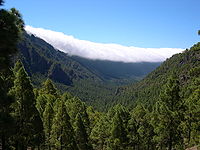
Photo from wikipedia
With the availability of satellite data from free data domain, remote sensing has increasingly become a fast-hand tool for monitoring of land and water resources development activities with minimal cost… Click to show full abstract
With the availability of satellite data from free data domain, remote sensing has increasingly become a fast-hand tool for monitoring of land and water resources development activities with minimal cost and time. Here, we verified construction of check dams and implementation of plantation activities in two districts of Tripura state using Landsat and Sentinel-2 images for the years 2008 and 2016–2017, respectively. We applied spectral reflectance curves and index-based proxies to quantify these activities for two time periods. A subset of the total check dams and plantation sites was chosen on the basis of site condition, nature of check dams, and planted species for identification on satellite images, and another subset was randomly chosen to validate identification procedure. The normalized difference water index (NDWI) derived from Landsat and Senitnel-2 were used to quantify water area evolved, qualify the water quality, and influence of associated tree shadows. Three types of check dams were observed, i.e., full, partial, and fully soil exposed on the basis of the presence of grass or scrub on the check dams. Based on the nature of check dam and site characteristics, we classified the water bodies under 11-categories using six interpretation keys (size, shape, water depth, quality, shadow of associated trees, catchment area). The check dams constructed on existing narrow gullies totally covered by branches or associated plants were not identified without field verification. Further, use of EVI enabled us to approve the plantation activities and adjudge the corresponding increase in vegetation vigor. The plantation activities were established based on the presence and absence of existing vegetation. Clearing on the plantation sites for plantation shows differential increase in EVI values during the initial years. The 403 plantation sites were categorized into 12 major groups on the basis of presence of dominant species and site conditions. The dominant species were Areca catechu, Musa paradisiaca, Ananas comosus, Bambusa sp., and mix plantation of A. catechu and M. paradisiaca. However, the highest maximum increase in average EVI was observed for the pine apple plantation sites (0.11), followed by Bambussa sp. (0.10). These sites were fully covered with plantation without any exposed soil. The present study successfully demonstrates a satellite-based survey supplemented with ground information evaluating the changes in vegetation profile due to plantation activities, locations of check dams, extent of water bodies, downstream irrigation, and catchment area of water bodies.
Journal Title: Environmental Monitoring and Assessment
Year Published: 2018
Link to full text (if available)
Share on Social Media: Sign Up to like & get
recommendations!